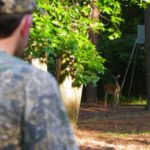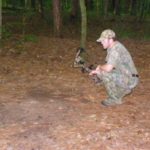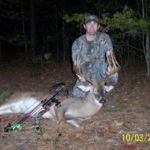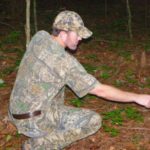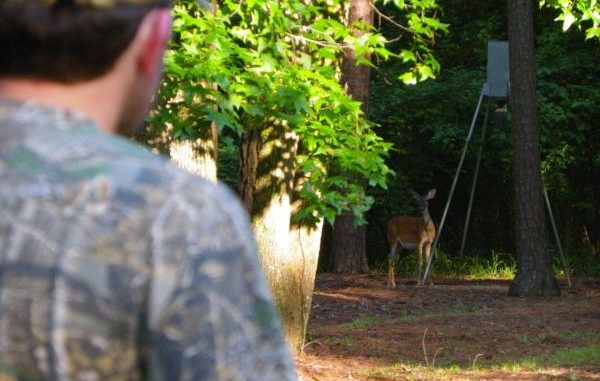
This hunter knows the secret to scoring meat for the table with a bow — and how to up his odds of taking a mature buck. Here’s how he does it.
Dan Preaus, owner of Shelter Insurance agency in Ruston, has been a bow hunter for the past 10 seasons. Hunting on Shiloh Hunting Club as well as family land in Union Parish, he has learned and accomplished a lot as a bow hunter.
However, he will quickly tell you there is so much more to know about the sport, and he learns something about going after deer with stick and string each time he heads for the woods.
“My uncle Mark talked me into giving bow hunting a try, and I was ready for the challenge,” the 33-year-old Preaus said. “After hunting deer practically all my life with a rifle, I was interested in trying something more challenging, and bow hunting really fits that description.
“I bought a Mathews Legacy bow when I started out, and it’s the bow I still use. I sort of go by the old adage, ‘If it ain’t broke, don’t fix it.’ It’s a bow I feel really comfortable using, and I’ve had a fair amount of good luck with it.”
That’s a bit of an understatement. During the 10 seasons he’s been a bow hunter, he has taken at least 15 deer with his bow.
Praeus said the first key to his success is how he approaches bow hunting.
“I take my bow hunting seriously,” he said. “I study the deer I’m hunting by doing lots of scouting, especially using trail cameras. As a result, I can get a fairly good idea of where good deer hang out and the times of day they are moving.
“I also get to know the lay of the land as accurately as I can. I want to know the location of the food sources, bedding areas, trails and such so when I hunt, I (can) be where the deer are more likely to be.”
Among the 15 or so deer he has taken with his bow, several have been bucks, including two trophies fine enough to have their mounts grace the walls of his Ruston office.
October 3 is a date Preaus probably circles on his calendar each year because both bucks — a 10-point buck taken in 2004 and a big 12-point bruiser he took in 2011 — were taken on that date.
Interestingly, both were taken from the same stand mounted in the same tree.
But the hunter said it’s been an evolution.
“When you’re a bow hunter, you’re always learning and looking for things to improve your chances with a good buck,” Preaus said. “For example, I probably wouldn’t have gotten the 10-point buck in 2004 if I hadn’t missed a good buck two days earlier. When this buck came in and presented me a shot, I admit I got buck fever, and in my excitement I shot over him.
“I was determined that this wouldn’t happen to me again, and on the next hunt I had a chance at the 10-point; I talked to myself and determined that there was no way I was going to miss again.
“After seeing it was a buck I wanted to take, I took my eyes off his rack and concentrated on the target zone, and when I got the sight picture I wanted, I released the arrow. I had just made up my mind I wasn’t going to let buck fever cause me to miss a deer again.”
There is a reason Preaus makes sure he’s in the woods so early in the season.
“I have found that early in bow season bucks are easier to pattern,” he said. “The rut hasn’t kicked in yet and the bucks are still hanging around together.
“They will travel the same general areas at about the same time each day, with their main interest being food rather than looking for does.”
That was proved when he stuck the 2011 trophy buck.
“When I got the 12-point, I had been seeing trail camera photos of this buck in company with two other smaller bucks — a spike and a small 8-point,” Praeus said. “I hunted the same stand two days in a row, and was skeptical about pressing my luck; I didn’t want to spook him by being in the same stand too often.”
A hunting buddy convinced him that, since the deer were presenting themselves during daylight hours and he hadn’t spooked them, he should give the stand another try.
“I left work that afternoon, changed into my hunting clothes and was on the stand just after 5, (p.m.)” Preaus said. “I sat until after 6:30 without seeing anything, but around 6:45 I heard some deer moving toward me.
“The 8-point stepped out and I could hear something behind him, and then I saw the rack and knew it was the big one.”
The two bucks took a trail that led them to within eight steps of his stand secured 20 feet up on a tree. The 12-point stopped in an opening, and Praeus released the arrow.
The deer only ran a short distance before collapsing.
When Praeus took the deer to Simmons Sporting Goods, it scored just under 150 inches.
“I got that buck and the 10-point seven years earlier by learning what they do in early October,” Preaus said. “It’s a sure thing that I’ll clear my calendar and be in the woods as often as I can in early season because it’s so much easier to figure them and their movement patterns out than it is when they’re chasing does.”
Just because bucks might be easier to pattern as the season first kicks in doesn’t mean they’re a push-over, however; care must be taken in hunting them so when a good buck presents himself, he’ll come in unaware a hunter is in the woods.
Want to improve your chances at taking a good buck this season? Follow the advice of Dan Preaus, a dyed-in-the-wool bow hunter who said he still has a lot to learn. From the success he has had in his 10 years of bow hunting, 15 deer including two impressive wall-hanger bucks, I’d say he has already learned a lot.
